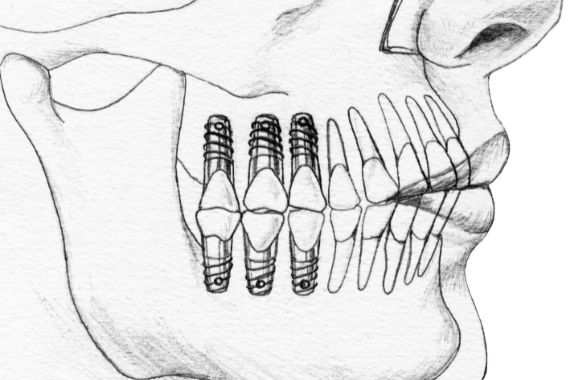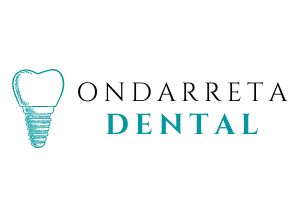
Dental implants
At Clínica Dental Ondarreta we are committed to the safety of our patients, which is why we only work with high-quality dental materials backed by the most demanding scientific standards. We will give you a certificate of authenticity for our Straumann® implants.
All our oral surgery and implantology treatments are performed using microsurgery and are therefore minimally invasive. This makes the postoperative period much more comfortable.
A dental implant is a titanium element that allows us to replace a tooth that has been lost. The implant is the anchor that will replace the root of the natural tooth.
Once placed in the bone, osseointegration occurs, which usually requires about 3 months. After this time, the implant will be used as a support for the placement of one or more dental crowns -caps- or for a dental prosthesis -complete denture-.
Dental implants are the most natural way to replace a missing tooth or teeth. They are designed to supply all the functions of the mouth: chewing, speaking and aesthetics in the most harmonious way possible. In addition, it allows you to avoid bone loss and maintain the rest of the teeth in your mouth.
Thus, the placement of dental implants is a comprehensive oral health solution for the patient who has lost a tooth and not just an aesthetic reason.

How do we place the Implants?
The surgery to place a dental implant is a procedure that is performed under local anesthesia and therefore completely painless, and if the patient requests it or it is considered for medical reasons, it can be performed under intravenous sedation. At Clínica Dental Ondarreta all surgical treatments are performed through microsurgery and are therefore minimally invasive.
The implant placement surgery is performed in our surgical box, a space designed for the greatest comfort of the patient: spacious, comfortable and with all the technical means and materials to guarantee surgical asepsis and patient safety.
Most implant placement surgeries do not usually take more than 30 minutes. Postoperative periods are usually very soft and comfortable, with recovery that usually does not take more than 1-2 days.
What are the phases of treatment?
Implant treatments are generally composed of three phases:
– Surgical phase:
1st Visit: Diagnostic visit with the surgeon and planning of the treatment plan.
2nd Visit: Preoperative visit, the procedure, preoperative instructions are explained and the necessary medication is prescribed. If necessary, hygiene is carried out.
3rd Visit: Placement of the implants in our surgical box under local anesthesia or conscious intravenous sedation if previously requested or indicated.
4th Visit: Postoperative control.
*The biological process of integration of the implant into the bone usually takes 3 months.
– Prosthetic phase (3 months after implant placement):
1st Visit: Taking impressions and sending them to our dental laboratory to make the prosthesis.
2nd Visit: Test and x-ray to confirm the correct fit of the prosthesis with the implant. Complex prostheses may require more than one trial before being delivered.
3rd Visit: Delivery of the prosthesis on the implant.
– Periodontal maintenance phase:
Implants and the crowns on them require periodic maintenance visits. The frequency of these visits may vary according to the particular needs of each patient.
– Conventional implants. They are dental implants that are placed in a space where there is no tooth, that is, the tooth was extracted at least 2-3 months ago.
– Immediate implants. They are dental implants that are placed in the same surgery/session that the extraction of the diseased or damaged tooth is performed. It is usually performed on the anterior teeth (incisors, canines) and premolars (small molars).
– Special implants. They are implants that are placed in special situations in which there is a large bone deficit, such as zygomatic implants or pterygoid implants.
Peri-implantitis is an infectious disease that affects dental implants and is the main cause of their premature loss.
Peri-implantitis is caused by many factors such as smoking, diabetes mellitus, poor oral hygiene, poorly controlled periodontal disease, poor fit of the prosthesis on the implant, poor surgical planning in the placement of the implants and lack of maintenance. of dental implants.
Early detection makes it possible to stop the progress of the disease and save the affected dental implants.
The treatment of peri-implantitis is based on an improvement in oral hygiene and health, a correct adaptation of the prosthesis held on the implants, and a surgical treatment to disinfect and/or regenerate the bone or gum of the diseased implant.
At Clínica Dental Ondarreta we carry out a personalized and meticulous study of each case, in this way, we guarantee the maximum success of each implantological treatment.
The dental implants that we place on our patients avoid the low-quality, low-quality implants so widely used in our country and which have caused so many problems. We work with the Swiss implant house with the highest international medical and scientific recognition Straumann® which guarantees the highest quality to our implant treatments.
The implant placement surgery is performed in our surgical box, a space designed for the greatest comfort of the patient: spacious, comfortable and with all the technical means and materials to guarantee surgical asepsis and the patient's medical safety.
One of the main problems with dental implants is the waiting time, between the placement of the implant and the placement of the definitive dental prosthesis -crown, denture-, which is usually a minimum of 3 months. During this period, the patient usually uses a removable provisional prosthesis - removable.
In most cases, this problem can be solved by placing the provisional prosthesis permanently on the same day as the implants are placed. This procedure is called “immediate loading”. In this way, we avoid waiting the usual 3 months for osseointegration of the implant with the bone by wearing removable “dentures” (removable) increasing quality of life and recovering function and aesthetics in less than 24 hours after surgery.
At Ondarreta Dental Clinic we have a highly developed methodology of teeth in 1 day (immediate loading) and immediate fixed provisionals that will avoid that long wait of 3 months to be able to show off a beautiful smile.
"The success, stability and durability of an implant lies in the quality of the bone that supports it."
Bone regeneration techniques are used to stimulate areas with little or no bone to form new bone. This set of techniques allows us to place dental implants in patients who did not have a sufficiently solid bone structure.
There are many bone substitute materials known as biomaterials. The most commonly used are autologous bone (from the patient himself), bone of animal origin (xenografts) or synthetic bone. Each biomaterial must be indicated in a personalized way according to the characteristics of each case. The biomaterial is covered with a collagen membrane to leave it protected.
When a bone regeneration technique is performed, you generally have to wait longer, between 3 and 6 months, for the biomaterial and the dental implant to integrate into the bone. The advantage is that, in most cases, the dental implant can be placed in the same surgical procedure as bone regeneration.
There are many types of regeneration such as maxillary sinus elevation - when there is no bone in the upper posterior sector -, guided bone regeneration - when a biomaterial and a membrane that covers them are used -, block grafts and special advanced techniques such as of bone formwork by Dr. Khoury and those described by Dr. I. Urban.
Regenerative surgeries usually take no more than 1 hour and recovery is usually quick (2-3 days). It is performed under local anesthesia and is sometimes complemented with intravenous sedation.
At Clínica Dental Ondarreta we are committed to the safety of our patients, which is why we only work with high quality biomaterials backed by the most demanding scientific standards: Straumann®.
There are many types of bone regeneration: the most common are maxillary sinus elevation and bone grafts.
Maxillary sinus elevation is one of the most used, safe and studied bone regeneration techniques. This technique is used when the patient does not have sufficient bone volume and height in the posterior area of the maxillary bone (area of the upper molars). It consists of the placement of bone biomaterial to gain the lost volume and height, thus allowing the placement of dental implants.
The maxillary sinus lift is a convenient and comfortable surgery whose duration usually does not exceed one hour. The postoperative period is mild and recovery is usually 2-3 days.
The absence of teeth has the following consequences:
- Bone loss (unstimulated bone tends to shrink)
- Possible displacements and complications at the level of other healthy teeth
- Decreased chewing function
- Digestion problems
- Aesthetic damage and modification of facial expression
- Speech difficulties
Dental implants allow these complications to be alleviated, providing a solution that is not only aesthetic but also functional.
Treatment with dental implants allows:
- Replace a lost tooth.
- Replace several teeth.
- Replace all teeth
In this case, implants make it possible to fix a bridge or stabilize a removable prosthesis.
Titanium has established itself as a reference material thanks to its high resistance and its excellent tolerance by the body (biocompatibility). It is very important to know that there are various types of materials and ranges of implants, at the Ondarreta Dental Clinic, we use the highest and highest quality range (Straumann), in addition to having the experience of our surgeon. For such a delicate treatment, it is best to go to clinics like ours, which combine experience and quality in something as "delicate" as Implants.
There is no upper age limit. Any elderly person can be a candidate for implant placement, as long as they do not have risk factors. On the contrary, implants cannot be placed in patients who are too young (approximately under 18 years of age). It is absolutely essential that jaw development has been completed.
From the preliminary examination to the placement of the prosthesis, the duration of an Implant treatment can range between 2 and 5 months.
The extent of the treatment (number of implants, increase in bone mass, etc.) will determine its duration.
The surgical phase consists of placing the Dental implants in the jaw bone. It is performed under local anesthesia and the postoperative period is mild.
The duration of the intervention ranges between 30 minutes and 2 hours, depending on its complexity (number and location of implants, volume of bone available, etc.).



